BY Mr. DIJKEMA
1- ABSTRACT
This contribution gives an overview of the state of the art in the Dutch molluscan shellfish industry. sanitary control and further regulations. Culture, fishery and processing of mussels, oysters and cockles are dealt with, as well as the organization of the different branches. A view is given of the present national standards for the protection of public health and management of shellfish stocks, implementation of the requirements, the necessary monitoring programs and corresponding laboratory methods. Attention is paid to research and development activities for the shellfish industry.
2- BIVALVE CULTIVATION AND FISHERY
The bivalve species cultivated and/or fished in the Netherlands on a regular basis are the Blue Mussel (Mytilus edulis L.), the European Flat Oyster (Ostrea edulis L.), the Pacific Oyster Crassostrea gigas (Gmellin) and the Cockle (Cerastoderma edule L.). Their average yearly production, cultivated and/or fished, is given in the table below:
| Production method | Mean production (Tons fresh weight) | |
| Mytilus edulis | Culture | 100,000 |
| Ostrea edulis | Culture+fishery | 200 |
| Crassostrea gigas | culture+fishery | 1,000 |
| Cerastoderma edule | fishery | 60,000 |
Other species, fished and/or marketed in minor quantities, are cut through shells (Spisula subtruncata - Da Costa), Whelks (Buccinum undatum L.), periwinkles (Littorina littorea L.) and scallops (Pecten maximus L.).
Mussels and oysters are produced by way of bottom culture. The shallow and exposed coastal waters only allow off-bottom culture methods on a very small scale. Fishery on wild banks in the coastal waters is practiced on seedling and half-grown mussels, the two oyster species, cockles and, in some years, on cut trough shells.
Mussel culture
Mussels are cultured in the Waddenzee (60 % – 75 % of the national production) (Fig. 2), and the
Oosterschelde estuary (Fig. l). Culture concessions or plots are mostly located on the banks of tidal
channels, from the intertidal range to 10–15 m below low tide level. They are demarcated with wooden
poles and measure between 7 and 25 ha. There are 78 mussel growers who together rent a total
area of about 10,000 ha. However, 30 % – 50 % of this is not or hardly utilized because of unfavorable
bottom or current conditions. An average grower cultivates 70–80 ha. From this area he harvests
between 900 and 1,5000 metric tons of mussels per year. In the period between 1984 and 1987
this represented for one firm a gross veiled of 375,000–850,000 Dutch Guilders (DFL). One DFL
equals about 0.6 US$
The nominal production of the Dutch mussel culture is about 100,000 tons per year. This yield fluctuates strongly (Fig. 3), due to varying mortality as result of gales in the Western part of the Waddenzee. Waves and currents then dislodge the mussels from the culture plots. Losses have been particularly high in the last decade. The production in the Oosterschelde is much more stable. The last two years, the production has been particularly low due to a combination of failing recruitment of mussel seed and storm damage on the culture plots and wild seed banks. To compensate the low production, mussels have to be imported, mostly from the German and Danish part of the Waddenzee, to satisfy market demand. Fig. 4 gives inland production and imports of mussels during the last years.
Natural, one year old seeding mussels, 2–3 cm long, are dredged, mainly in the Waddenzee. As fishing for wild mussels is prohibited, permission is given to the mussel growers to fish for spat during 6 weeks in May/June and one week in September in designated areas. Certain areas are closed for seed fishery for reasons of nature protection. If these are available, the mussel growers also take halt-grown mussels (3–4cm), growing on wild banks in the intertidal range. These mussels are hardy (thick shell and trained adductor muscle), and need less time to reach the minimum market size 40 % longer than 50 mm). These mussels are preferred for the fresh trade to more distant export markets. The smaller seeding mussels are often seeded directly on deeper plots, where growth rate is higher and they can reach market size by November. These mussels can obtain a high meat yield (up to 35 – 40 %) of the fresh weight), but have a thin, fragile shell and a shorter shelf life. For this reason they are preferred for the conserve industry.
Predators which can inflict serious damage are eider ducks (Somateria mollissima), which can cause a mortality of 20,000–30,000 tons per year, see-gulls (Larus argentatus), oystercatchers (Haematopus ostralegus) and starfish (Asterias rubens). These predators are able to completely clear a culture plot containing, for instance, 100 tons of mussels within a few days. Seagulls, attracted by the processing plants, constitute a special problem, as their excrement's can cause incidental increases in coliform counts in the water. Birds are difficult to chases away. The mussel producer's organization in Yerseke employs a falconer, who keeps the processing plants free from seagulls with a hawk and a peregrine falcon. Eider ducks are seared away with noise. On the intertidal plots, sometimes, hunters can be killed with salt. They can also be dredged up with a special, spiked «stardredge», and killed with salt. They can also be dredged up with mussels and all and killed in the hold of the ship by immersion in fresh water during one night. The mussels survive the operation and are seeded back on the plot.
The mussels generally reach the required market size in 1.5–2 years after sowing of the spat. On very productive plots, this size is even reached at the end of the first growing season, in November. Most of the mussels are, however, harvested in the course of the following season, which runs from mid-July to the first week of April. The efficiency of the culture, as of a any form of bottom cultivation of mollusks, is low compared with off-bottom culture methods. As an average, 1.5 tons of mussels are harvested from 1 ton from 1 ton of half-grown mussels. On the most productive plots, it is possible for a skilled grower to achieve a higher efficiency and harvest. For instance, 3 tons from 1 ton of seed, when he applies low stocking densities and is spared from heavy mortality. Seeding density of the spat ranges between 3 and sometimes as much as 10 kilograms/m2, the latter especially in years when seed and half-grown mussels abound on the wild banks. Mortality on the culture plots is high, often reaching 90 % or more of the individuals seeded. At harvest, the density of the mussels is 6 – 8 kg/m2.
The ships with which the mussels and the seed are dredged mostly measure 30 – 35 long and 6 – 9 m wide and have a draught of 0.6–0.8 m. They can load 120 – 150 tons of mussels (Fig.8). A shipload can be fished in 4 – 5 hours with 4 dredges, each 1.9 m wide. Most of the ships have double bottoms and sides. This permits unloading of the mussels by pumping water into the two holds, after which they are washed out by gravity. This causes minimal damage to the mussels; Meanwhile, the ship circles over the plot in order to spread the mussels evenly.
Most of the mussel cultivating firms are independent family enterprises. There is, however, a change towards firms with shared capital, as is already the case for most of the merchants and exporters and the mussel processors. They are 78 growers, owning 86 ships. A few larger grower's firms own more than one ship. A regular mussel «cutter» is manned by a skipper (often the proprietor), a mate and a deck hand. The culture plots are rented from the government. The total rent for the growing plots, following a drastic increase in 1990, rises stepwise from DFL 750,000 to DFL 4,300,000. Each grower will eventually be charged according to his share in the total landings. In the old situation, the culture value of the plots is also being taken into account.
After harvest, all mussels are shipped to the township ofYerseke at the Oosterschelde (Fig. 1), where the central mussels auction is located. There the mussels are sold to the highest bidding mussels merchant. After a merchant has bought a lot of mussels (mostly 50 or 120 tons), and prior to processing them, he has to relay the mussels on his own plots, situated at 20 minutes sailing distance from Yerseke. On these «rewatering plots» the mussels have to be relaid for at least 14 days. During this period weak and broken mussels are eliminated by seagulls, crabs and fishes and the survivor recover from stress, contracted during fishing and the 12 hour transport from the Waddenzee to the Oosterschelde. Finally, the plots sere as «wet warehouses» for the merchants.
After rewatering, the mussels are dredged up carefully avoid stress and breakage. In contrast with the mussel ships of the growers, on most of the merchants' ships the catch is not dropped into the hold, but directly from the dredge placed into containers on deck. This minimizes stress and damage and increases quality and shelf-life. The containers, which contain 4–7 tons of mussels, are hoisted ashore at the processing plant, where the mussels pass a rotating rinsing sieve to remove mud. Then a final de-sanding treatment is carried out. The double-bottomed containers with the mussels are connected to a sea water distribution system, which creates a vertical flow through the layer of mussels. At a number of firms, this water is UV-Sterilized to bacteriological purity. During a period of 4–6 hours, the mussels cleanse themselves and discard the last rest of sand which after dredging has remained in the intestinal tract or in the mantle cavity.
Purification of bivalves in depuration systems prior to marketing to remove human pathogens, which is compulsory in a number of countries, is not necessary in the Netherlands, as all shellfish waters meet the required national bacteriological standards, as well as those of the European Community (see below).
When the mussels are ready for processing or marketing, they pass a de-cumpling mill to break up clups formed with the byssus threads and pass a blower to remove algae (mostly sea lettuce - UIva lactuca) and empty shells. Then de-byssing takes place and, if necessary, grading. Mostly, cultured mussels are rather uniform in size and do not need grading. After final manual sorting out of damaged mussels, stones, peat etc, the mussels destined for the fresh market are cooled down to a temperature of 7 – 70°C, which is compulsory during storage and transport, and are packed in 20 kg wholesale bags or in 1,2 or 2,5 kg perforated plastic bags for home consumption.
Oyster culture
Culture of the flat oyster Ostrea edulis is carried out on culture plots in the southeastern part of the
Oosterschelde (1,700 ha) and in non-tidal Lake Grevelingen (380 ha) (Fig. 1). Spat is collected
during summer on mussel shells, which are seeded on culture concessions or plots on the sea bottom.
After two years, the seed oysters are fished up and re-seeded to other plots where growth rate
is higher.
Market size is reached after 4–5 years from spatfall at a weigh of 65–90 gr. The biggest oysters are marketed at a weight of 100–200 gr. The 16 Dutch oyster growers and exporters used to produce about 10 millions (800 tons) of flat oysters per year until 1990. About half of this amount originated from fishery on wild banks. After the introduction and subsequent outbreak of the epizooty caused by the protozoarian Bonamia ostreae in the Oosterschelde estuary in 1980, fishing and culture of O.edulis in lake Grevelingen, which had not been infected, kept the Dutch oyster industry afloat (Dijkema, 1988). In 1988, however, bonamiasis also broke out in lake Gevelingen. The resulting mortalities between 40 and90 % have reduced the production of oysters to not more than 200 tons in 1990 and 1991. The varying mortality rate and the uncertainly as to the development of resistance in the oysters, makes the perspectives for production very uncertain.
The pacific oyster (Crassostrea gigas), locally by its French name «creuse», has been cultivated in the Oosterschelde from the late seventies, after it was introduced from Japan in 1964. The decision to introduce this species had been made after the Portuguese oyster Crassostrea angulata had virtually died out due to a gill disease. The introduction was decided upon in the supposition that the summer water temperature maxima in the area (21 – 24°C) would be too low for successful recruitment and development of a natural population. The contrary proved true: recruitment appeared to be surprising in some years, probably due to warming up of enclosed intertidal pools of water during low tide. After about 10 years, wild oyster banks appeared on intertidal dike slopes and sandflats. Natural spatfall or significance is now occurring every few years and constitutes the main source of spat for culture. Spat is collected on mussel shells, seeded on plots in the tidal range. The culture plots used are mostly situated in shallow water. There is a small commercial nursery, producing seed oysters from imported spat.
Cockle fishery
Although pilot-scale growth and re-seeding trials with this species have been successful (Dijkema et
al, 1987), no commercial culture exists in the Netherlands. Both the mechanical and the hand cockle
fishery are practiced in the Waddenzee (70 % of the catch) and the Oosterschelde 20 %. About
10 % of the cockles are dredged in the subtidal waters off the coast. The last decade, the fishery
yields yearly 5,000–10,000 tons of cooked meat, equivalent with about 30 – 60,000 tons of fresh
cockles. The production of the last years has strongly declined as a result of failing recruitment and
closure of areas by the government for reasons of nature protection. Figure 5 gives an overview of
the development of cockle landings in the Netherlands. The fishing season runs from the end of
August to December. In total 36 cockle dredging ships are licensed to fish in the inshore waters, another
7 ships are only allowed to fish in the offshore area. The dredgers measure about 35 × 10 m and
have a draught of 0.5 m. A ship is equipped with two one meter wide suction dredges. The cockles
and the sediment are whirled up by means of a water jets at the front side of the dredges and are
scooped up by a 4–5 cm deep steel blade. They then come in a mesh cage, from which the catch is
continuously pumped aboard. There the cockles are separated from water and sand in rotating sieves.
On a number of vessels, the catch is spread out on deck and immersed in sea-water for a de-sanding
period of a few hours prior to cooking. Most of the cockles are cooked on board. Cooking is done at
low tide, when fishing on the intertidal flats is not possible. Special cooking locations are designated
in areas where the bacteriological quality of the water is approved. After being cooked, the
cockles are shucked on vibration sieves, are rinsed and often cooled. There is one deep-freeze factory-ship.
The meat is shipped to shore, where it is further processed.
Before 1960, all cockles were fished manually, by means of long-stemmed rakes with attached bagnets. At present, 80 licensed manual cockle fishermen dig for cockles in the intertidal flats of the Waddenzee and the Oosterschelde. Between them they take about 5,400 tons of fresh cockles per year. A part of their catch they sell to processors, the larger categories are sold fresh and exported to Belgium and France. The number of licenses has recently been restricted to 90 for reasons of wildlife protection.
3- ORGANIZATION OF THE INDUSTRY AND MARKETING
The molllusc industry is, just like all other sectors in the fishing industry, united in the so-called Board for Fish and Fish Commodities. This board has two functions: in the first place it is, by law, responsible for the implementation of a number of legal tasks, delegated to it by the government. These tasks comprise the control of sanitary purity of molluscs and the control of introduction of toxins phytoplankton species into the Dutch coastal water. Secondly, the Board negotiates, with the government authorities on behalf of the industry about regulatory matters such as closed areas and seasons, import and export regulations, seed fishery for mussels etc. Each of the different sectors: the mussel, the oyster and the cockle industry have Advisory committees in the Board, in which the chairmen of their different associations sit.
Mussels
The degree of organization of the mussel growers and traders is the highest in the Dutch fishing
industry. Besides being represented in the Board for Commodities mentioned above, the mussel growers
are organised in a producers Cooperation. They have associations in each of the three mussel
harbour towns and additionally are united in two regional fishermen's organizations. There is an
association of mussel traders, processors and exporters, which has a seat in the Mussel Advisory
Committee. Most of the growers are well aware of the importance of uniform quality standards.
Membership of the producers Cooperation, according to EC regulations, is not compulsory.
However, more than 90 % are members and consequently all growers have to comply with its regulations,
pertaining to the quality of the produced mussels. These regulations are decided upon at the
beginning of each season and encompass, among others, a minimum size (a shell length of 40 % of
the mussels longer than 50 mm), a minimum meat yield (16 % meat of fresh weight), and a minimal
percentage of tare. There is a minimum price in the season 1989–1990 established at DFL 0.24 per
kg. The Mussel Office of the Board for Commodities administers a number of funds, financed with
specific levies per ton of mussels landed or marketed, from which matters such as the mussel auction,
landing registration, research and promotion are paid. The mussel auction, managed by the
Mussel Office of the Board, is the only existing in the country and probably even in the world. Its
personnel samples all cargo's of mussels offered for auctioning. The sampled mussels are weighed,
measured and cooked to determine their meat yield, also the amounts of tare and barnacles are determined.
This information is provided to the potential buyers, the 27, accredited mussel
merchants/exporters, most of whom have their plants in Yerseke. A voluntary intervention fund
exists for mussels which do not meet the requirements for size or meat weight, or do not fetch the
minimum price. These mussels are sown on special plots and sold back to the growers in April, after
conclusion of the season.
In the trading and processing industry, the firms are generally larger than in the cultivation sector. About 65 % of the national production of mussels is sold fresh by the 27 merchants who clean, debyss and pack the mussels destined for the inland market 15 %, Belgium (60 %), and France 15 %. The other The other 35 % of the production are processed. A variety of commodities is offered to the consumers, like Individually Quick Frozen (IQF), breaded, deep frozen in the half shell. on skewers, pasteurized or sterilized in glass jars with all kinds of sauces, or just «au naturel». promotion is financed jointly by producers and traders. It encompasses manifestations such as «free-for-all» mussel festivals, TV commercials, posters, pamphlets and recipe booklets in both the Netherlands and in the export countries.
Such aimed campaigns have succeeded in enhance the inland mussel consumption by almost 50 % during the last decade. Due to the proximity of the main export markets: Brussels (1.5 hours by road), Antwerp (45 min.) and Paris (5 hours), the fresh product reaches its destination in a matter of hours after having left the sea. To ensure optimal quality, transport takes place in cooled trucks at a temperature of 7 – 10°C, in summer after pre-chilling in cooled water at the processing plant. In some instances, mussel traders are also active in mussel and cockle processing. Since 1989, most conserve firms are integrated in large multinational food chains, which also comprise cockle fishery and mussel and oyster culture. Besides, a number of firms is engaged in import and export of periwinkles lobsters, crabs etc. In this respect, the favorable location of Yerseke at the Oosterschelde with its good water quality, ensures optimal possibilities for transit storage of live seafood. To be able to import mussels from areas where «red tides» can occur without risking introduction of toxic blooms in the Dutch coastal waters, a number of mussel traders disposes of on-shore quarantine installations, in which up to 40 tons of mussels can be kept in recirculating seawater for 2 or more days. These systems, as well as similar installations for on-shore storage of imported oysters, have recently been developed by the Netherlands Institute for Fishery Research (RIVO-DLO).
Oysters
Most oyster growers export their own product. Apart from his culture plots, which he rents from the
government, an oysters grower own a ship, and owns or rents a number or tidal on-shore storage
basins and a building in which cleansing, sorting and packing of the oysters take place. The start of
the season for Ostrea edulis depends on the meat quality: plumpness and taste, and the shelf-life, of
the oysters. It mostly starts in the first week of September and peaks during the feasts between
Christmas and New Year, when 70 – 80 % of all oysters are sold. The season generally end after
Eastern. The strong decline of the production of flat oysters after the bonamiasis outbreaks makes
substantial imports of oysters from countries like Ireland, Greece and Turkey. Export of the cupped
oyster Crassostrea gigas takes place almost year round, with emphasis on December. Most of the
production goes to Belgium, increasing quantities also to Germany. In years when the production in
France is low, as was the case in 1992, there is also export to that country. The inland consumption
of pacific oysters is small. There are three associations of oyster growers, represented in the Oyster
Advisory Committee of the Board of Commodities. The associations coordinate communal seeding
of mussel shells for spat collection and organize a cooperative fishery on wild flat oysters. They
administer an auction in which the catch of this wild fishery is sold. For each season, agreements are
made about the weight classification of the oysters.
Cockles
The about 19 companies which own the 36 cockle-dredging licenses are organized in two associations.
There is also an association of hand-cocklers. All these associations are represented in the
Cockle Advisory Committee of the Board. Regulations exist for the minimum size of the cockles (15
mm shell width), a mean size (expressed as the number of cooked individuals per kg) of the cockles,
the percentage of damaged cockles in the catch and the width of the blade of the dredge, which is 1
m for two dredges and 1.20 m for one dredge. Size and engine power of the ships are not regulated,
which has caused a substantial increase of the fishing power of the fleet and hence of cockle landings
during the last decade (Fig. 5). Cockle meat is mostly canned (ca70 %), IQF or block frozen.
The entire production is exported, mainly to Spain and Italy. Diversification of the product is more
and more emphasized. This results in a spreading of the export market, which was initially restricted
to Spain. The major share of capture, processing and export is in the hands of about 4 large companies,
who are parts of 2 British food chains. Together they own 21 of the 36 licenses.
4- PUBLIC HEALTH STANDARDS FOR SEA WATER AND MOLLUSCAN SHELLFISH MEAT QUALITY
General
By 1993, the economical borders between the countries of the European community will disappear.
Consequently, control measures will not longer be carried out at the borders, but only at the sites of
origin of the products and, in case of imports from non-member countries, at the external borders of
the Community. Uniform regulations will then be implemented for the waters in which shellfish are
kept, for conditions during storage, processing and transport and for the quality of molluscan shellfish,
imported from outside the EC. Directives will give standards for the quality of waters in which
molluscs are cultured, fished or stored (Directive 79/923/EEG of 30 October, 1979) and will give
prescription for production and marketing of live bivalves, as well as requirements for import and
export to on-member countries (Directive 91/492/EEG of 15 July, 1991). Notably the last directive
is meant to protect the consumers. The implementation of both directives is at present being prepared
by the member-countries. An overview of the present national regulations in the Netherlands,
which will in due time be substituted by EC standards, will be given in the next section.
The directive 79/923/EEG gives standards for the quality of waters in which molluscs are cultivated, fished or stored. In the Netherlands, the same standards are at present maintained by the Ministries of Agriculture, Nature Management and Fishery and of public Works and Waterways. Standards prevail for the following environmental parameters:pH, temperature, color intensity, suspended solids concentration, salinity, oil, flavor, taste, coliforms and coli bacteria, dissolved oxygen, halogenated organization carbons and a number of metal. In general, the standards mean that the values of these parameters may not exceed the values under natural conditions by a certain factor. For all parameters, sampling frequencies and often determination methods are prescribed.
Partly cover, and in future substituted by the standards of the Directives of the European Community, national quality standards are maintained for shellfish water and molluscan shellfish. These standards are laid down in the governmental decree for the pureness of Molluscan Shellfish. This decree is implemented by the Board for Fish and Fish Commodities and us ultimately controlled by the National Management and Fisheries.
Bacteriological standards
Worldwide, coliform bacteria or the species Escherichia coli are used as indicators for the presence
of human pathogens mainly entroviruses and hepatitis virus, originating from fecal contamination of
the water. specific determinations are additionally made for Salmonella.
For molluscan shellfish water
- Conform the E.C. standard.
For molluscan shellfish flesh
- Less than 300 thermotolerant E.coli in 100 ml molluscan flesh+intervalvular liquid.
- Absence of Salmonella in 25 ml molluscan flesh + intervalvular liquid.
Chemical standards
For molluscan shellfish flesh
- Mercury : <0.7 mg/kg mollusc flesh + intervalvular liquid.
- Cadmium : <1.0 mg/kg mollusc flesh + intervalvular liquid.
- Lead : <2.0 mg/kg mollusc flesh + intervalvular liquid.
Biological standards
For molluscan shellfish water
- The total number of Dinoflagellates in relation to the total number of phytoplankton organisms (diatoms + dinoflagellates) must be lower than 15 per 100.
For molluscan shellfish flesh
- Absence of lipid-soluble biotoxins originating from dinoflagellates, e.g. breve-toxins (NSP) and Dinophysis toxins (DSP).
- Concentration of water-soluble biotoxins originating from flagellates not higher than 40 microgram per 100 ml of mollusc flesh + intervalvular liquid (saxitoxin - PSP).
- Concentrations of water-soluble biotoxins originating from diatoms not higher than 20 mg/kg mollusc flesh + intervalvular liquid (domoic acid - ASP).
- Absence of atypical, «foreign», flavors and tastes.
Fishing and cultivation areas where values of phytoplankton or toxins exceed the standards, are closed. In (parts of) the Wadden Sea toxicity occurs with a frequency of roughly once in 4–5 years. The OOsterschelde has been partially affected by toxic blooms only two times in history. The mussel stocks on the rewatering plots in this area (Fig. 1) have never been touched by toxicity and are sufficient to ensure production during the closure of (parts of) the Wadden Sea.
Physical standards
For molluscan shellfish flesh
The concentrations of radio-active nuclides may not exceed:
| 80 Bq/kg | Alpha-emiters |
| 1,250 Bq/kg | Cesium isotopes |
| 2,000 Bq/kg | Iodine-istopes |
| 750 Bq/kg | Strontium islopes |
5- QUALITY STANDARDS FOR IMPORT OF MOLLUSCAN SHELLFISH
The quality standards for imports as well as for domestic landings and sales of cultivated and fished fish and shellfish and their commodities, are maintained by the National Inspection for Livestock and meat, part of the Ministry of Agriculture, Nature management and Fisheries. Organoleptical. bacteriological, chemical, toxicological and radioactivity analyses are either carried out in the laboratories of this service or are performed by contracting laboratories, for instance the Netherlands Institute for Fishery Research (RIVO-DLO). For import into the Netherlands, the quality and sanitary pureness of mussels and oysters, as well as the water they originate from, have to be testified by certificates, issue by competent, accredited authorities in the countries of origin, stating that he following standards are met :
Bacteriological standards
For molluscan shellfish water
- Not more than 50 E. coli per Litter, in 10% of the cases not more than. 150E. coli per litter. on condition than in all cases the requirements concerning the flesh are not exceeded.
For molluscan shellfish fresh
- Conform the E.C. standards
Biological standards
For molluscan shellfish water
- The total number of Dinoflagellates in relation to the total number of phytoplankton organisms (Diatoms and Dinoflagellates) should not be lower than 15p per 100.
For molluscan shellfish flesh
- Absence of lipid-soluble biotoxins (e.g. breve toxins (NSP), Dinophysis toxins (DSP).
- Less than 40 microgram per 100 ml of oyster or mussel meat. Paralytic shellfish Poison (PSP) PAS saxitoxin. Less than 20 mg/kg domoic acid.
- Absence of atypical, «foreign», odors and tastes.
For the determination of Diarrhetic Shellfish Poison (DSP), the rat bio-assay method is applied (sec above). The standard : «absence of DSP» in practice means a negative rat-biosassay outcome, based on feeling hepatopancreas-tissues to starved rats on a basis of 10% of the live weight of the animal. A negative outcome corresponds with a does of less than 10 mg okadaic acid per standard rat of 100g.
Phytoplankton blooms causing Paralytic Shellfish Poisoning (PSP) do not occur in the Dutch coastal waters. However, they have been reported in almost all of the surrounding countries. The risk of introducing into the Dutch coastal waters the dormant stages or «cysts» of dinoflagellate species which can cause PSP, is considered very high, as large amounts of cysts can be present in mud. imported together with mussels. In order to minimize this risk, it is prohibited to immerse in Dutch coastal waters imported shellfish, unless :
- these originate from the Wadden Sea bordering the North Sea, pertaining to Germany or Denmark;
- mussels are cleansed, debyssed and packed in consumers package;
- they are kept in quarantine installations which guarantee that no effluent of any kind can reach the coastal water, unless it is sterilized in an approved manner,
- it can be proven that waste water from processing operations as well as tare, do not reach the coastal waters.
Biological standards for molluscs, concerning the protection of their stocks and of the marine environment.
- Absence of micro-organizations, pathogenic for molluscan shellfish and/or parasites and/or predators, as well as of dinoflagellates, responsible for the production of biotoxins and/or their cysts.
Chemical and physical standards
- Equal to the standards for domestic shellfish.
6- REQUIREMENTS FOR THE EXPORT OF MOLLUSCAN SHELLFISH
The National Inspection Service for Meat and Livestock of the Ministry of Agriculture, Nature management and Fisheries is also authorized and equipped for the inspection of all fish and shellfish destined for export. Inspection is performed at the request of the exporter and/or of the country of destination. RAandom samples are taken of all lots of shellfish destined for export. If a lot is approved, a certificate for export or a health certificates is issued. The inspection is done at the level of «fit for human consumption», but may also contain any other additional elements. A quality inspection with «indicated quality grades» is possible. The norms used for this inspection are based on the governmental «Decree on the quality of fish and fish products», which also applies to all fish and shellfish, imported, landed and sold on the domestic market.
7- CURRENT MONITORING PROGRAMS FOR QUALITY CONTROL OF MOLLUSCAN SHELLFISH WATERS
Bacteriological quality
Two, complementary, programs exist for monitoring the bacteriological quality of the Dutch shellfish
water : one is carried out according to the requirements of the EC on a quarterly basis in all molsh
rearing and fishing water (fig. 6). It is carried out by the Netherlands Institute for Fishery
Research (RIVO-DLO) in Yerseke in cooperation with the Ministry for Public Works and waterways.
Under normal circumstances 5 samples of mussels or cockles, with a distance between them
of a cast 100 m, are taken on each of 8 fixed locations in each of the 6 shellfish growing and fishing
areas in the country (Fig. 6). These samples are analyzed for E coli bacteria, the median value for
each location is reported. Another monitoring program is additional to the quarterly sapling program.
On a weekly basis, mussel and water samples are analyzed on 8 locations, with emphasis on
sensitive areas, such as culture plots, oyster storage basins, the mussel rewatering plots and the area
where the for de-sanding of the mussels is pumped up (Fig. 1). In order to keep a close watch
on sanitary water quality, these samples are taken much frequently than at the3 months intervals,
prescribed for the BC monitoring Program. Incidental high values are immediately reported to
the industry and relevant authorities. This program goes beyond the requirements of the EC for sanitary
monitoring, but is considered essential to be able to guarantee a good sanitary quality of the
exported molluscs. The sampling locations for this program are shown in Fig. 1.
Determination of E. coli
The concentrations of thermotolerant fecal colibacteria (E. coli) in the coastal waters of the
Netherlands are so low that they attain the detection limits of the current laboratory methods. This
is mainly a result of measures, already taken many years ago, to deduct all public sewage flows to
other areas. Instead of direct determination in water, concentrations in mussels, which are sampled.
When these are absent, young mussels or cockles are used. If these also are absent, mussels from
others locations are placed in the water at the sampling location for al least on day, during which the
bacterial numbers in their intestinal tracts reach an equilibrium with those in the surround water.
The mussels are then sampled as usual. Determination of the concentrations of E. coli in shellfish
meat is done, using incubation on McConky agar plates at 44.5 i0,2°C during 24 hours. If positive,
confirmation is carried out of 10% of the colonies found, using lactose, brilliant-green bile broth
medium and the Kovacs reaction to test for indol formation. As the levels founds in water samples
alone are generally too low to give reliable and conclusive analysis results, only mussel samples are
examined.
Chemical water quality
Monitoring the coastal and inshore water for pollutants such as heavy metals, Polycyclic Aromatic
Carbons (PAC's), Pesticides and many other parameters is carried out by the Ministry of Public
Works and Waterways on a monthly basis. The concentrations of these pollutants in fish and mollusc
tissue are monitored on a yearly basis by a combination of institutes of the Ministry of
Agriculture, Nature management and Fisheries. A higher frequency of sampling is not necessary as
all concentrations found lie below critical standards. Coordination, sampling and part of the determinations
are done by the Netherlands Institute for Fishery Research (RIVO-DLO).
Biological water quality
Monitoring the coastal waters for toxic phytoplankton is done weekly by RIVO-DLO during the period
July – November, or longer if deemed necessary. Water samples are taken in all mollusc growing
areas and in the North Sea of the Dutch coastline and examined microscopically (see below). The
18 sampling locations are indicated in Fig. 7. The presence of Dinophysis toxins (DSP) in mussel
flesh are determined by means of rat-bioassay. Another, monthly, monitoring program is carried out
at by the Ministry of Public Works and Waterways on 17 locations (Fig. 7a) in the coastal water
(TRIPOS, 1991). This program is aimed at the general species composition of the phytoplankton.
The method, followed by RIVO-DLO for rat bio-assay is a modified version of that, described by
Kat (1983). As test animals white, female wistar : Rattus norvegicus), with a body weight increasing
from 80 – 100 g to about 300 g.
Procedure
A test animal of known body weight is starved for 24 hours, starting at 16:00 pm. Drinking water supply is ad libitum.
After 24 hours (again at 16:00 pm) hepatopancreas tissue of the mollusc to be examined is fed to the test rat in portions of 10 grams of hepatopancreas per 100 g of body weight.
The results of the test are recorded the next morning at 09:00 am. The (partial) refusal of the hepatopancreas and the consistency of the faecal produced (diarrhoea of soft faeces) are used for scaling the presence of diarrhetic she shellfish toxins according to the following schedule :
| Percentage of hapatopancreas eaten | Consistency of the faeces | Degree of toxicity | Rating | |
| 100 – 90% | normal | negative | - | |
| 100 – 90% | normal/soft | very slightly toxic | ± | |
| 90 – 50% | soft | slightly toxic | + | |
| 90 – 50% | soft/diarrhetic | moderatcly toxic | ++ | |
| > 50% | diarrhoea | seriously toxic | +++ |
In case of total refusal of the hepatopancreas tissue, an admixture is prepared with normal rat fodder, type RMH-B, obtained from Hope Farms B.V., PO Box 85, Woerden, Netherlands, in an appropriate ratio (e.g. 1:1 or 2:1, etc…).
Standardized in okadaic acid, the detection limit of the test is 10 – 50 microgram per rat of 100 grams. As the first symptoms of intestinal disorder in humans may arise at about 50 micrograms (Edebo et al.), a rating of «+» may produce its first effect in men at a portion of 10 – 50 g of hepatopancreas tissues, which corresponds with about 20 – 100 g of shellfish meat.
8- RESEARCH AND TECHNOLOGICAL DEVELOPMENT FOR THE MOLLUSCAN INDUSTRY
Many technical development activities are carried out by the industry itself. Most bigger firms have technical departments which develop their own gear and machinery. For instance, a large manufacturer of mollusc processing equipment is specialized in process technology and machinery. It serves a part of the industry, but is mainly depending on foreign markets. There are two governmental institutions for research and development in fishery :the Netherlands Institute for Fishery Research (RIVO-DLO) in IJmuiden, which has a filed station for mollusc research in Yerseke, and the fisheries department of the Institute for Agriculture Economics (LEI), both part of the Ministry of Nature Management and Fisheries. These institutes also give advice to the Ministry for governmental fishery management Although they are governmental institutions, they also carry out contract research and consultancy services, both in the Netherlands and abroad. RIVO-DLO concentrates on the biological (stocks and ecosystem aspects), environmental (impact and water quality research) and technological aspects of fishery and aquaculture, but also carries out contract research into seafood quality fish products technology. Below, a survey is given of the experience and know-bow in the field of mollusc culture and fisheries, available in the Netherlands :
Netherlands Institute for Fishery Research (RIVO-DLO)
- Zootechnical aspects of mollusc culture.
- Stock assessments of bivalves and benthic organisms.
- Research into growth mortality and condition of molluscs.
- Development of recirculated on-land storage-facilities for live shellfish.
- Monitoring of toxic phytoplankton in coastal waters, determination of DSP in shellfish sing rat-bioassay.
- Sampling and monitoring pollutants in fish and shellfish.
- Fishing gear technology : traditional and suction dredges.
- Site-selection for mollusc culture : currents, food, supply, water exchange, exposition.
- Evaluation of aquaculture projects and proposals.
Institute for Agricultural Economies (LEI)
- Economical analysis of sectors of the industry and individual firms or projects.
- Marketing research, development cooperation projects.
- Evaluation of projects and proposals.
Franken B.V., Goes
- Processing and culture of molluscs.
- Processing plants and equipment.
- Off-bottom culture projects.
LITERATURE
• DIJKEMA, R. - 1988 - Shellfish cultivation and fishery before and after a major flood barrier
construction project in the southwestern Netherlands
Journal of Shellfish Research - Vol. 7 - №2 : pp. 241 – 252
• DIJKEMA, R. - VAN STRALEN, M.R. - 1989 - Development in mussed cultivation in the
Netherlands after a large-scale coastal engineering project.
World Aquaculture - December 1989 - In press
• DIJKEMA, R.- VAN STRALEN, M.R.- 1989 - Management-supporting research into interaction
of bottom culture of mussels (Mytilus edulis 1,) with local ecosystems in the Netherlands.
International Council for the Exploration of the Sea - 1989 - EMEM/B°70
• DLIKEMA, R. - BOL, J. - VROONLAND, C.S, - 1987 - Enhancement of the production of cockles
(Cerastoderma edule L) by thinning out a dense natural bed and reseeding, Oosterschelde, SW
Netherlands
Inter. Council for Exploration of the Sea - CM.- 1987/5 :12 P.
• KAT, M. (1983) - Diarrhetic mussel poisoning in the Netherlands related to the dinoflagellate
Dinophysis acuminata.
Antonie van Leeuwenhock - 49 : pp, 417–427
• KORRINGA, P. - 1976 - Farming Marine organisms low in the food chain
Volume on mussel farming - Elsevier - Amsterdam
• LANGE, X. - LI. P. - ALLENMARK, S.- 1988 - Toxic mussels and okadaic acid induce rapid
hypersecretion in the rat small intestine.
Acta Pathologica, Microbiologica
• TIOPOS - 1991 - Biologische monitoring van fytoplankton in de Nederlandse zoue cu brakk ewateren
in 1991
Tripos, Haren Rijswijk.
Figure 1 - Oosterschelde and Lake Grevelingen - Shown are the flood barrier, the mussel rewatering plots, Yerseke and, with circles, the locations of the weekly sanitary monitoring program.

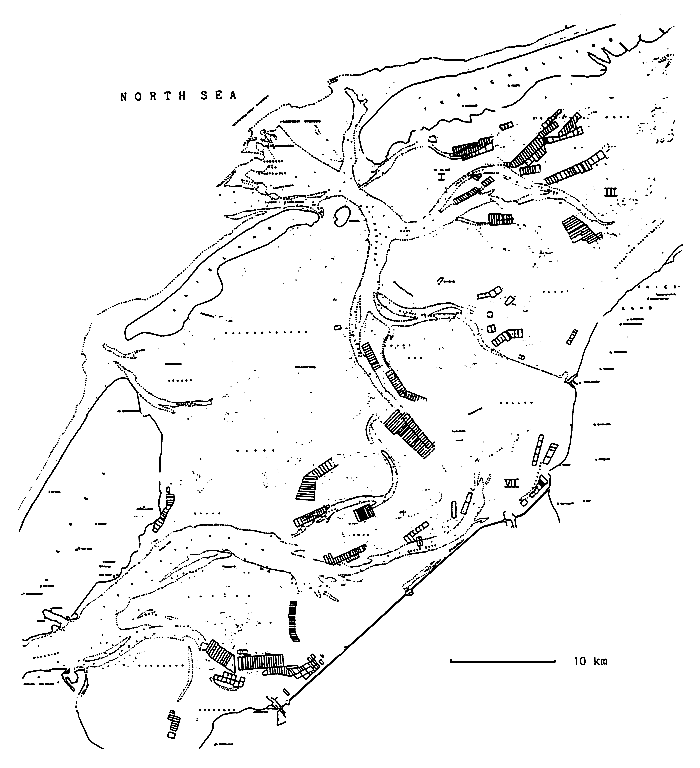
Figure 2 - Western part of the Waddenzee with the mussel cultivation plots.

Figure 3 - Total production of mussels in the Netherlands and from the areas Waddenzee and Zealand

Figure 4 - Production of the Dutch mussel culture and mussel imports per season (July–April) in the period 1985–1992.
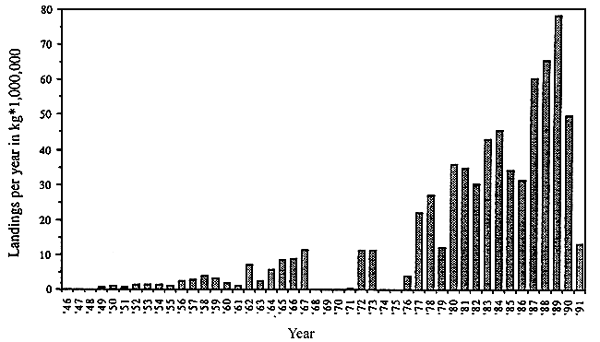
Figure 5 - Landings of cockles (Cerastoderma edule in fresh weight in the Netherlands since 1946.
From '68 – '70 and '74–'75 no data available.

Figure 6 - Sampling locations for the quarterly bacteriological monitoring Program.
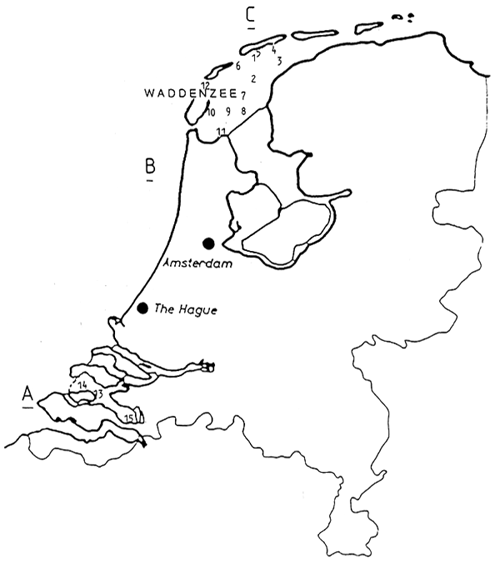
Figure 7 - Sampling locations for the monitoring Program for toxic phytoplankton species in the Waddenzee, the Oosterchelde and the North Sea.
6, 12 A, B, C : Water samples for phytoplankton composition
1,13 : Water samples + Mussel samples for toxicity
2 – 11, 14, 15 : Mussel samples only

Figure 7a - Sampling stations for monthly phytoplankton composition monitoring by the Ministry for Work and Waterways.

Figure 8 - Diagram of a Dutch mussel dredger - Scale approximately 1 : 175.
By Mr. J.C. SAUVAGNARGUES

LES PRINCIPAUX SITES DE PRODUCTION CONCHYLICOLES EN FRANCE
LES COQUILLAGES EN FRANCE EN 1985
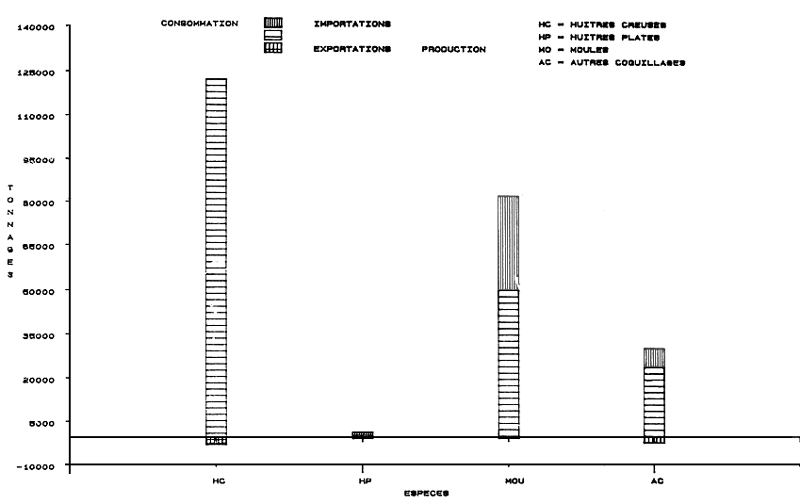
Sources : DIRECTION GÉNéRALE DES DOUANES
COMITÉ CENTRAL DES PÊCHES MARITIMES
PRODUCTION DE COQUILLAGES MARINS DANS LA C.E.E. - 1985
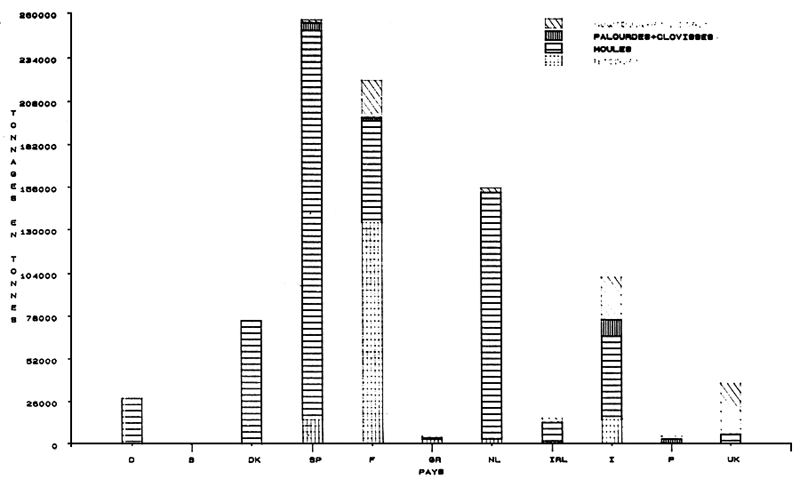
ÉVOLUTION DE LA PRODUCTION FRANÇAISE DE COQUILLAGES
(en Tonnes)
| 1980 | 1981 | 1982 | 1983 | 1984 | 1985 | 1986 | 1987 | 1988 | 1989 | |
| Huîtres crucuses (c.gigas) | 95 200 | 82 700 | 77 000 | 119 800 | 110 700 | 120 000 | 117 300 | 129 900 | 128 000 | 129 000 |
| Huîtres Plates (o.edulis) | 4 200 | 2 500 | 1 400 | 1 200 | 2 300 | 1 500 | 2 200 | 2 500 | 2 000 | 1 500 |
| Moules | 72 700 | 81 000 | 71 000 | 48 700 | 52 900 | 44 300 | 61 500 | 55 300 | 51 200 | 50 000 |
| Palourdes (cultiveées) | 2 | 4 | 10 | 100 | 200 | 400 | 420 | 560 | 450 | - |
| Autres coquillages (gisements naturels) | 30 100 | 26 400 | 25 730 | 21 000 | 19 300 | 20 800 | 21 200 | 24 900 | 28 100 | 21 600 |
| Valeur Totale (en millions) FF | 925 | 999 | 1 001 | 1 412 | 1 662 | 1 456 | 1 801 | 1 837 | 1 849 | - |
Sources: Comité Central des Pêches Maritimes
SEASONAL CONSUMPTION OF MUSSELS IN FRANC
(From Rivages & Culture №16 - juin1989)
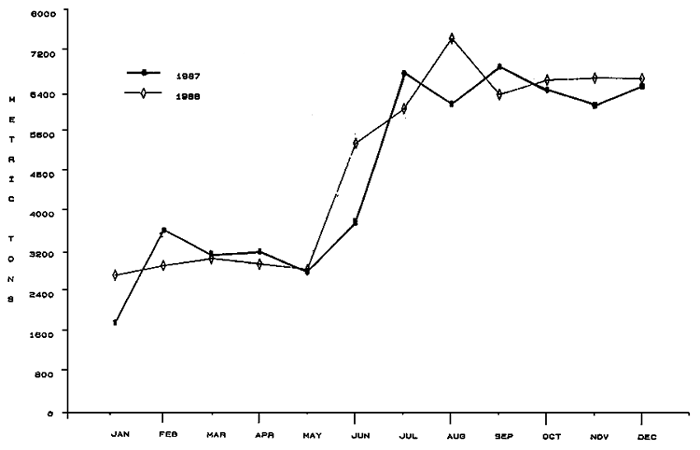
SEASONAL CONSUMPTION OF OYSTERS IN FRANCE
(From Rivages & Culture № 16 - juin1989)
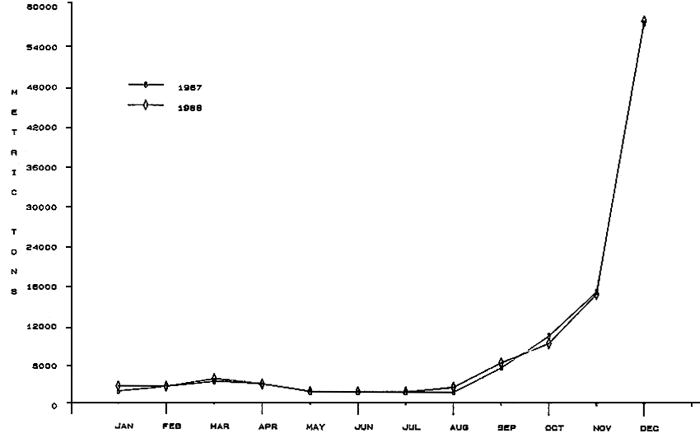
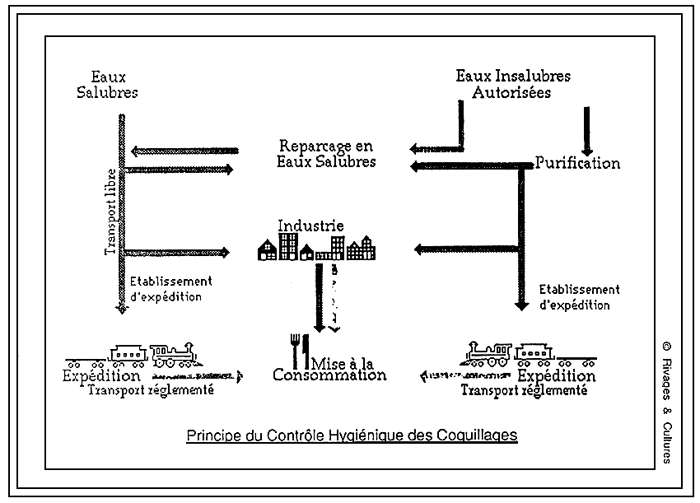
PRINCIPE DU CONTRÔLE HYGIÉNIQUE DES COQUILLAGES
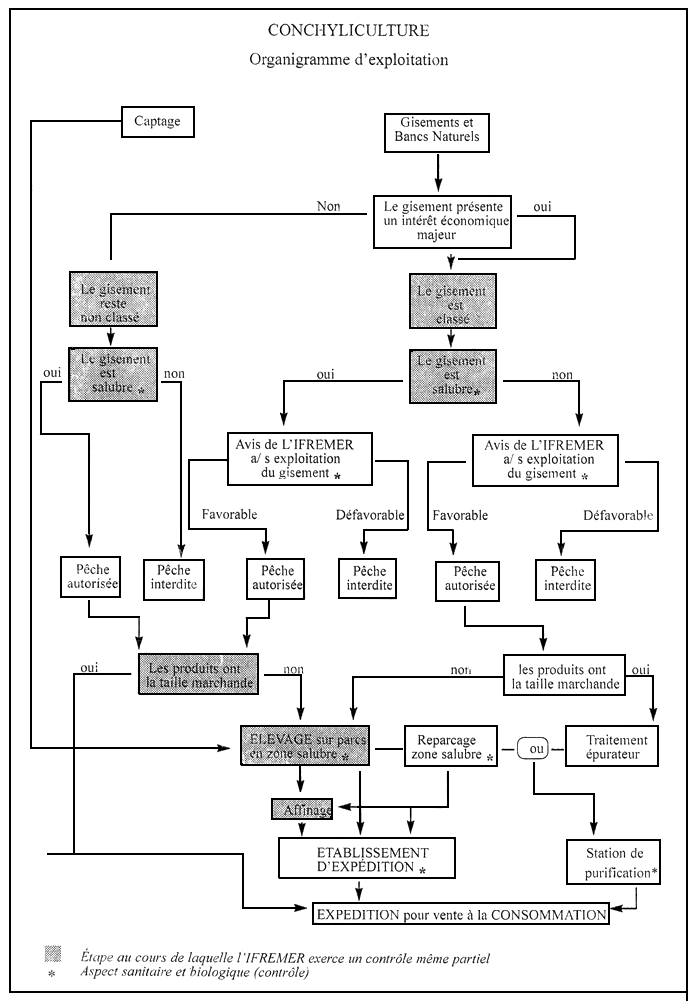
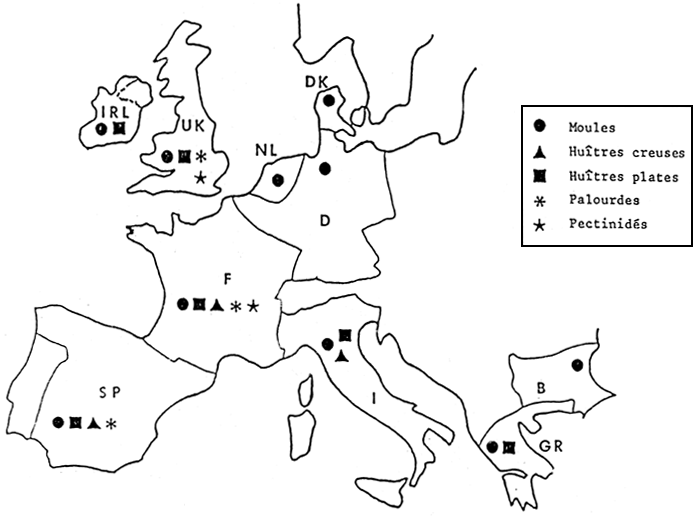
LES PRINCIPAUX SITES DE PRODUCATION DE COQUILLAGE EN EUROPE
D'après Philippe PAQUOTTE:IFREMER-SETE
(Shellfish Culture in Europe - Seminars in California - U.S. - October 1987)
RÉSEAUX DE SURVEILLACE
| RNO | Phytoplancton | Dactériologie | |||||
| Eau | Mat.vivante (coquillages) | Suivi (eau) | Alerte (eau+conquit.) | Survellance (conquillage) | Intervention (conquillage) | ||
| Mise en place | 1974 | 1978 | 1984 | 1984 | 1989 | 1989 | |
| Objectifs | Environnemental (niveaux-tendances) | Environmental (niveaux-tendances) | Sante publique Protection cheptel | Environnemental (niveaux-tendances) | Sante publique | ||
| Indicateurs | T°, S. sels nutritifs | Hg, Cd. Pb, Zn, Cu,pcb, ddt, ddd, dde, ahch, lindane, hydrocarbures | Liste floristique complète | • Espèce phytoplanctoniques toxiques | Coliformes totaux Coliformes Fécaux | Coliformes totaux Coliforms fécaux Salmonelles | |
| - | Dinophysis accuminata et sacculus | ||||||
| - | Gyrodinium aureolum | ||||||
| - | Alexandrium minutum | ||||||
| • Test souris | |||||||
| Zones concernées | Préférentiellement les zones estuariennes | sur l'ensemble du littoral | Zones conchylicoles et secteurs reconnus soumis à des efflorescences phytoplanctoniques toxiques | Secteurs conchylicoles (n = 56) | Secteurs conchylicoles (n=56) | ||
| 11 | 43 | Secteurs non conchylicoles (n=36) Total=92 | |||||
| Fréquence | Hiver-étéseulement 2 à 5 campagnes par an | Trimestrielle | Bimensuelle (september à Avril) Hébdomadaire (Mai à Août) | Minimum hébdomadaire | Mensuelle | Minimum hébdomadaire | |
| Nombre de Points | 129 | 93 | 24 | (24+44) 68 | (théorique) 50 | (théorique) 35 | |
| Positionnement des points | systématique | systématique | systématique | Renforcement autours des points de suivi | systématique | Positionnement en fonction du gradient decontamination | |
| CF/100 ml de chair de coquillage | |||||
| MILIEU | PRODUITS | ||||
| Arrêté du 12/10/1976 | Arrêté du 21/12/1979 | ||||
| Fréquence | Fréquence acceptable per classe | Produits réputés dangereux | |||
| 300.000 | 10m | ||||
| Produits qualité non satisfaisante | |||||
| 9,000 | 30 m | ||||
| Qualité acceptable si moins 3/5 résultats compris entre 3.000 et 9.000 | |||||
| 0 % | Résultat non acceptable | 3,000 | Qualité non satisfaisante si plus 3/5 résultats compris entre 10 m et 30m | 10 m | |
| 8 % | 8% | Résultat très suspect | |||
| 1,000 | |||||
| 19 % | 11% | Résultat suspect | Résultats satisfaisants | ||
| 300 | m | ||||
| 100 % | 91% | Résultat acceptable on satisfaisant | |||
| 0 | |||||
Tableau № 7- Coquillages - Normes de salubrité
Plus de 87 % des tonnages de coquillages produits en France répondent au critére < 300 CF/100 ml, selon une enquête récente.